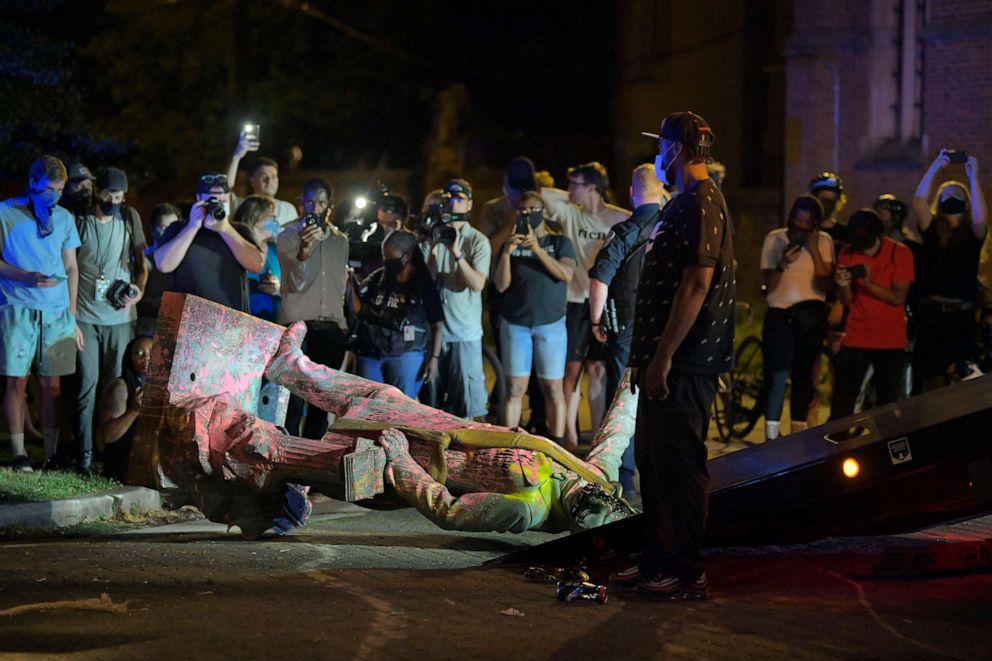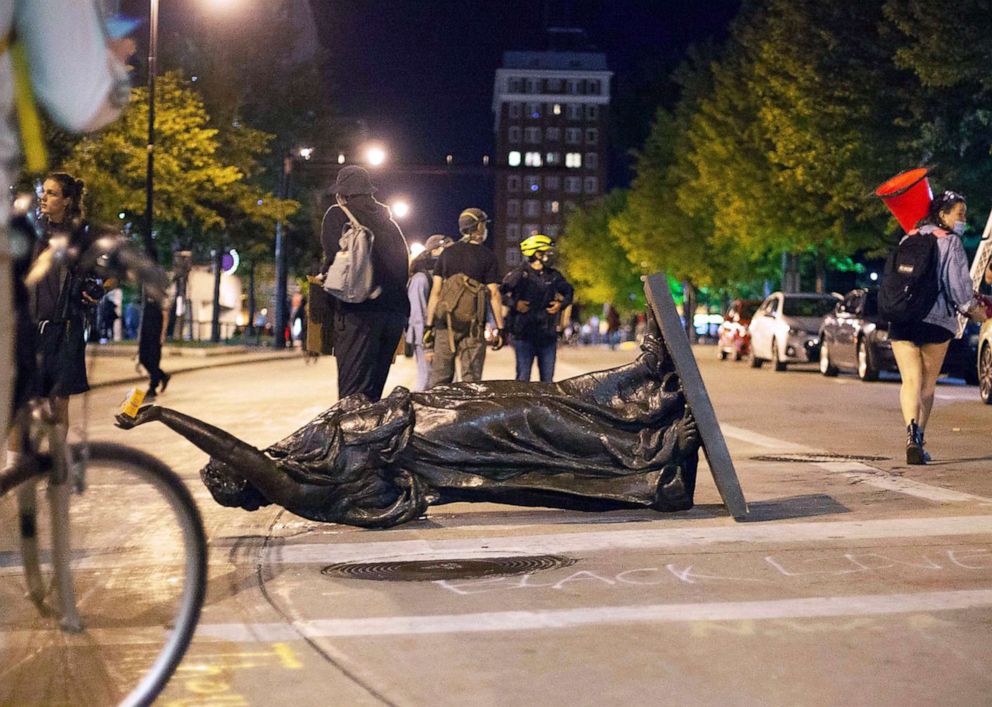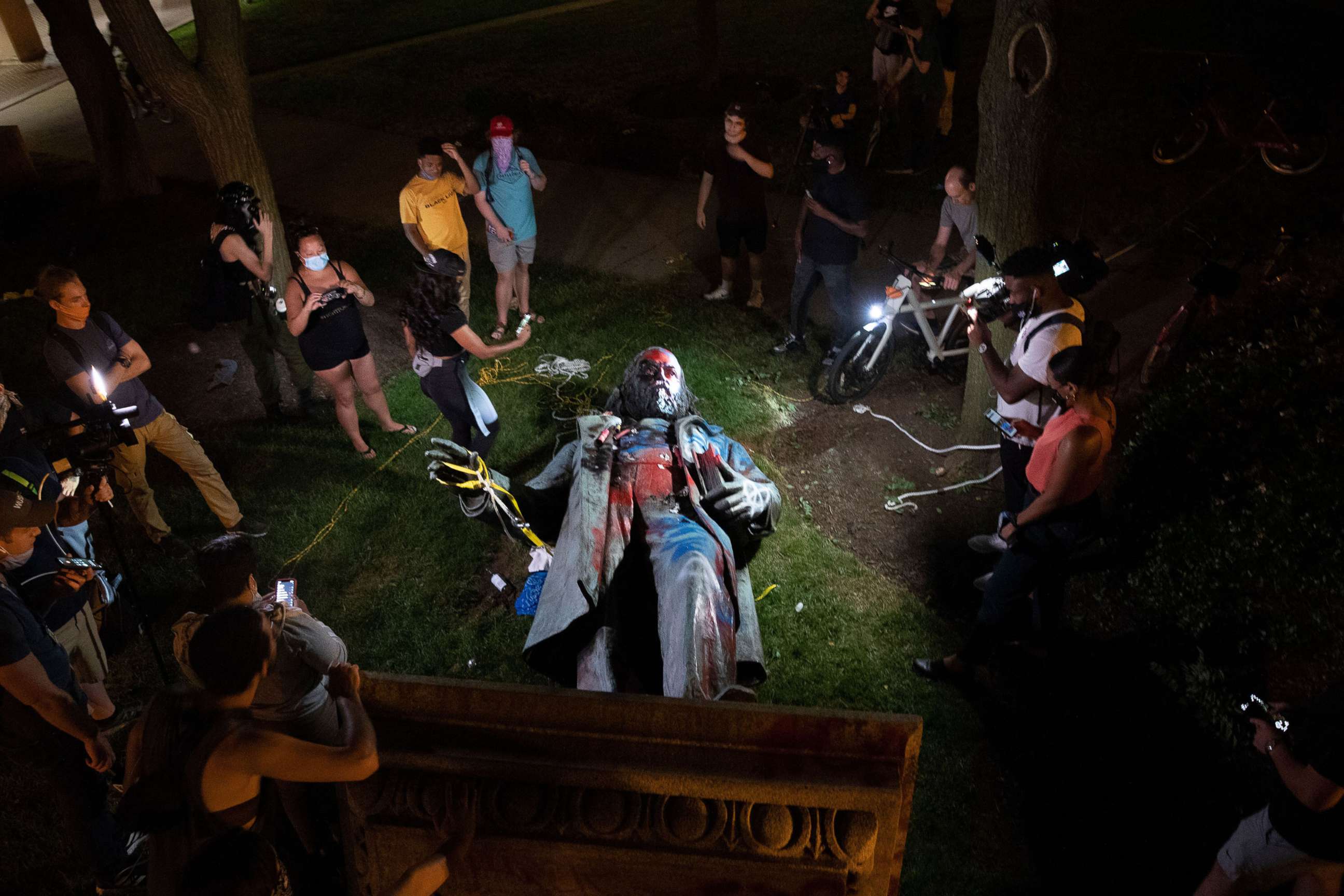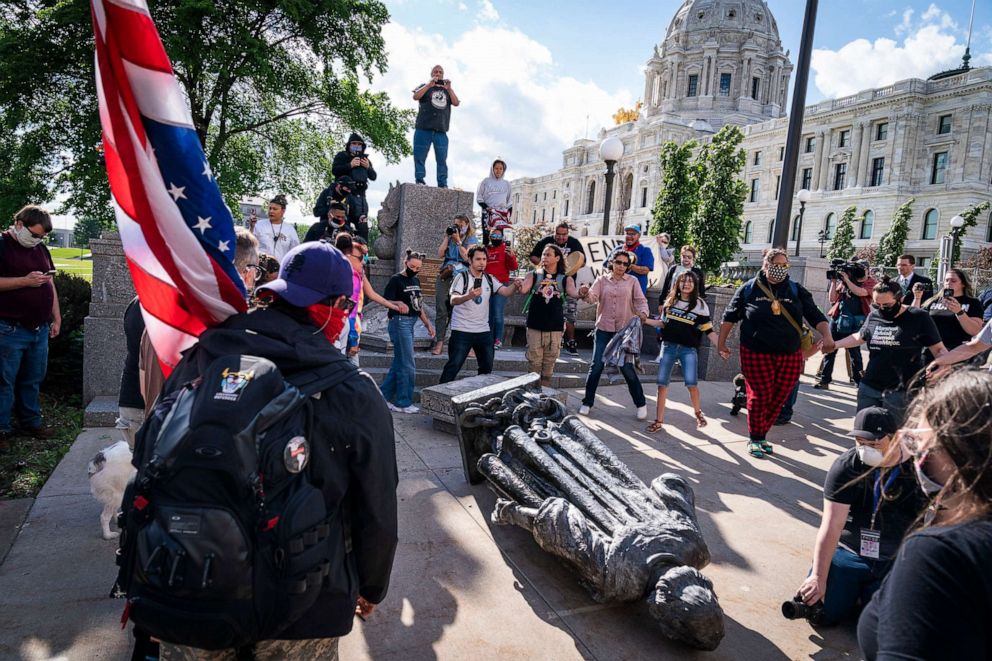Historians debate America's history of racism and Confederate monuments
Protesters have dismounted several statues around the world.
Statues have long been a way to honor leaders, benefactors, heroes and the war dead, giving them permanence and a three-dimensional presence.
Over the years, they have come to mean many things to different people, including a way to remember, a work of art or simply a place for pigeons to roost.
But increasingly some of those statues, particularly those honoring Confederate leaders or victories and those connected with slavery have become a flash point for many -- removed or destroyed because of the pain, suffering or oppression they represent.
This push, which has ebbed and flowed over the years, recently gained renewed momentum after the death of George Floyd at the hands of Minneapolis police in May, with statues either removed by protesters, the government or private organizations.
Not all agree that these historical representations should be taken down. President Donald Trump and Secretary of State Mike Pompeo have denounced "rioters" for pulling down the statues.
Trump even signed an executive order to protect monuments, memorials and statues, and has tweeted about jailing protesters for up to 10 years.
"I have authorized the Federal Government to arrest anyone who vandalizes or destroys any monument, statue or other such Federal property in the U.S. with up to 10 years in prison," the president tweeted on June 23.
But as some fight to preserve the monuments, even a descendant of Lee, Rev. Robert Lee IV believes they should be taken down now.
"Why are we protecting statues that symbolize oppression instead of protecting the people that were oppressed?" Lee said to ABC News in a July 3 interview.
In some cases, looters and vandals used the guise of peaceful protests to destroy property including statues dedicated to slave owners, Confederate leaders or other white men with controversial reputations. Many of those historical figures were prominent slaveholders and slave traders who acquired their fortunes through unpaid labor.
But experts interviewed by ABC News say erasing the past isn't the answer to calls for justice, police reform and an end to structural racism. What to do with the statues, which are expensive to maintain, is a more complicated question, whether it be removal, which is also expensive, adding context, which may be insufficient, putting them in museums or destroying them altogether.
'Statues have always been about power'
Historians have debated the issue for decades, with some saying cities and other locales should keep the sculptures intact and accept the historical figures for who they were -- warts and all -- while others see them as symbols of racism, oppression and African American pain.

"These individuals who are being celebrated ... their sole purpose was to destroy the country. And the second thing is that they lost ... a war to dissolve the country, and they were traitors," Lionel Kimble, vice president for programs at the Association for the Study of African American Life and History, told ABC News. "And I don't know of any other society, globally, where we hold up traitors and people who wanted to destroy the very fabric of ... society."
Erin Thompson, an art crime professor at the City University of New York's John Jay College of Criminal Justice, said statues generally weren't created to foster goodwill, but as an intimidation tactic.
"Statutes have always been about power," said Thompson, who has a doctorate in art history and a law degree. "From the beginning of human art-making, we see statues of rulers of powerful people and they're meant to send messages ... to keep reminding people that they're in charge."

"And because statues are about power ... when someone in power fell, their statues were attacked ... a way of sort of humiliating someone whose actual body you can't touch," Thompson added.
Kimble agreed, explaining that many Confederate statues were meant to elicit fear in opponents, and said they were also used as tools to terrorize Black citizens, including those who fought on the side of the Confederacy in the South.
"I think there are really two conversations going on. On one hand you have the Confederate monuments, which have a very checkered history as many of them were created as instruments of racial terror, instruments to support Jim Crow to oppress Black people in the south," Kimble said. "And a lot of these statues came, not as a direct result of the Civil War, but really in response to Jim Crow and the civil rights movement. So a lot of these things were designed to terrorize black people."
Conversely, the statues of the country's founding fathers, who were also predominately slave holders with histories of racism, are generally regarded in a different light, despite their pasts.

"The argument around these individuals as slaveholders is really a historical fact. These guys were some of the original American capitalists ... they made their money through the buying and selling of human beings," Kimble said. "In the larger American imagination, the Confederate statues occupy a very different space than statues of the Founding Fathers, which were erected to commemorate their work," he added.
During the recent protest, statues of historic figures like Robert E. Lee, Christopher Columbus, Ulysses S. Grant, Edward Colston and Jefferson Davis were torn down in the United States and overseas.
But Kimble said this is the wrong direction to take.
"We essentially want to cancel these Civil War generals and monuments, which I think is a mistake. Tearing these things down should not be the goal in," he said. "But there is a place for these statues and the place is in some sort of museum and not in the public space, which is meant to be shared by all people."
Shifting opinion
A recent Quinnipiac University poll found that there are significantly more people who support removing Confederate statues from public spaces around the United States than from a couple years ago.
"Historic figures in granite and iron that seemed protected just a few years ago now face the wrecking ball of public opinion," said Quinnipiac University polling analyst Tim Malloy.

According to the poll, in August 2017, 39% supported the removal of Confederate statues compared to 52% who wanted to get rid of them in June. Of those who support the idea in the latest poll, 84% are Black, 58% are Hispanic and 44% are white. Those that opposed their removal are 52% from Southern states and 64% from rural areas.
In Bristol, England, where a statue of Colston, a 17th-century slave trader, was tossed into the river, the monument was unofficially replaced with a statue of Black Lives Matter activist Jen Reid.
Bristol Mayor Marvin Rees referred to the Colston statue as one of the city's "dirty" secrets, but did not condone the statue's unauthorized removal.
The statue of Reid is in honor of her "life's work," which is the ongoing movement against racism and police brutality there and abroad. Twenty-four hours after Reid's statue was erected, the city council ordered it taken down and placed into a museum along with Colston's statue.
What to do about controversial statues?
Thompson said there have been several ideas floated to avoid removing statues, which costs just as much in some cases as it does to take care of them.
She suggested re-contextualizing statues with plaques that give context. "But seeing somebody up on a pedestal is so powerful that it's hard to believe that putting up a little bit of additional text, or putting up another statue nearby is really going to overcome that effective," she added.
Friends of the Public Gardens, a Boston-based community restoration organization said that "the cost for cleaning a piece of sculpture is approximately $700, while the cost for full restoration can be $20,000-$25,000."
The Smithsonian Magazine found in 2018 that during a 10-year period, nearly $40 million of taxpayer funds were spent on cleaning and preserving Confederate monuments, including statues.

"I also think a lot about where we allocate our preservation dollars because there are incredibly important Native American and African American historical sites that are just crumbling away because it's really hard to get funding to preserve," said Thompson.
And relocating controversial statues to museums isn't a simple solution.
"Museums have all sorts of stuff that they don't have room to display or don't have staff to conserve. And so it's not just as easy as treating a museum like the nation's attic for embarrassing racist stuff," said Thompson.




